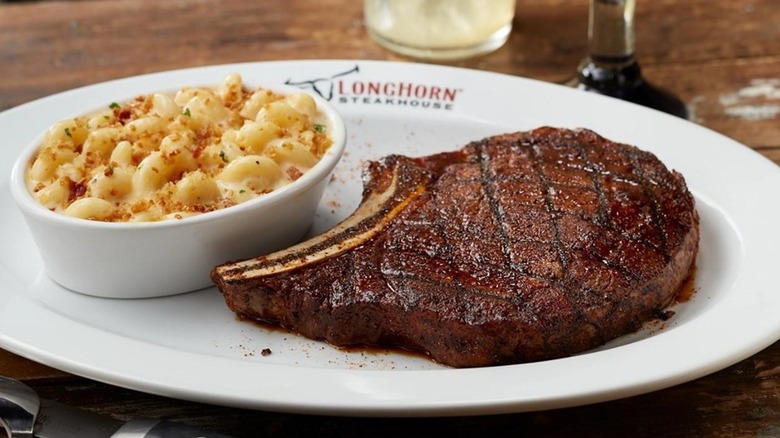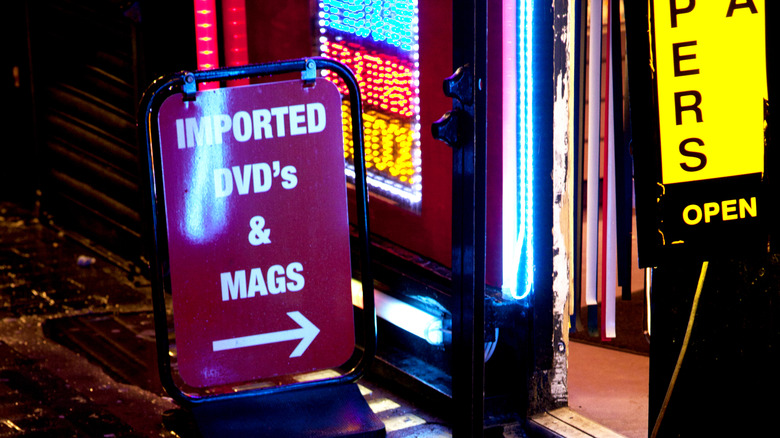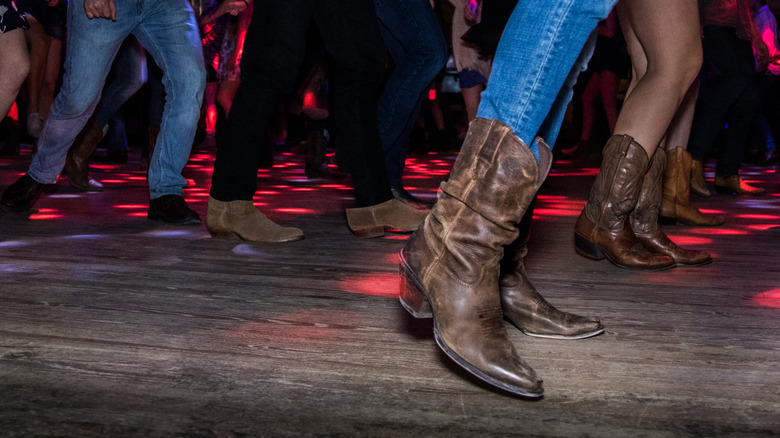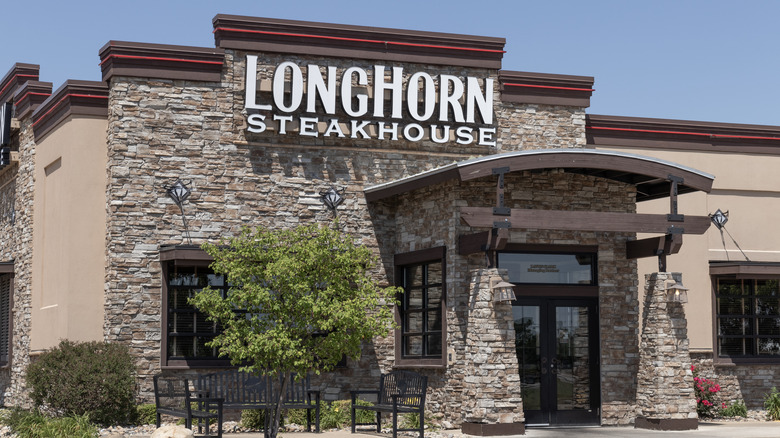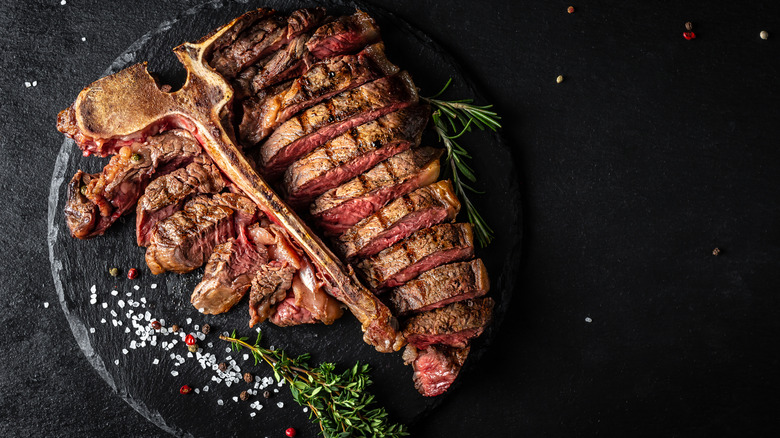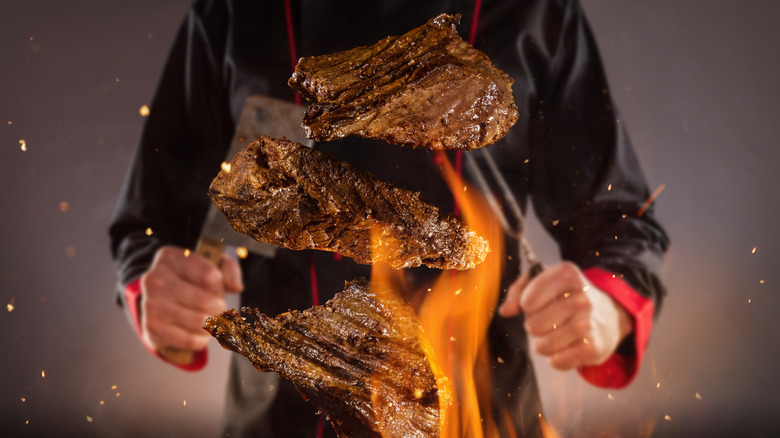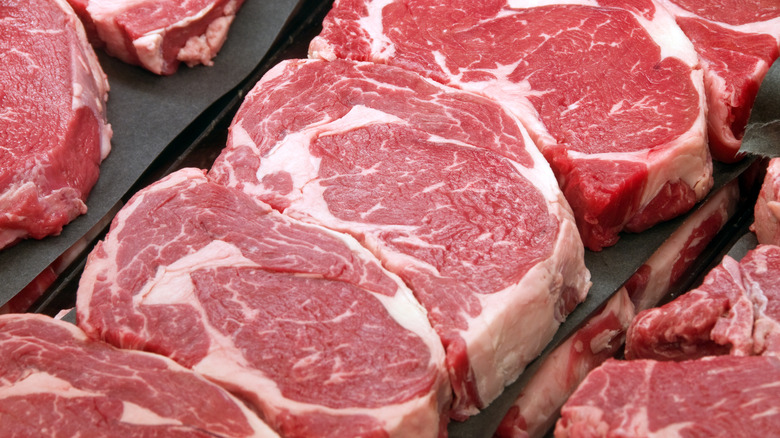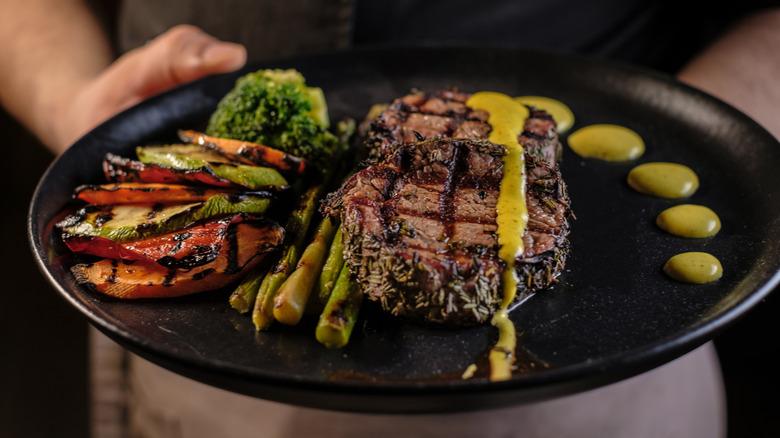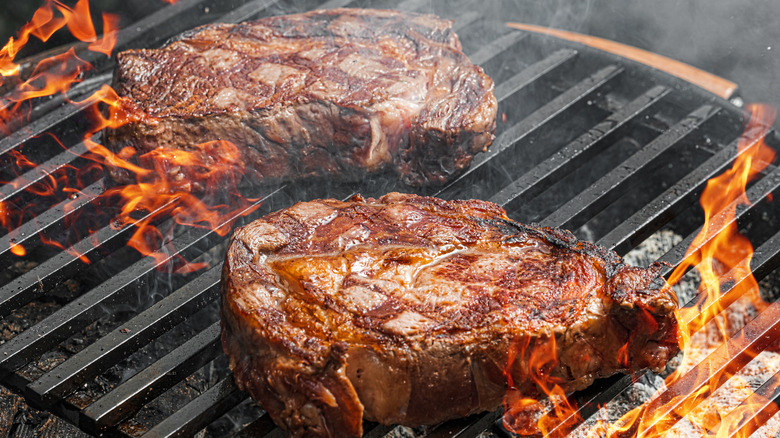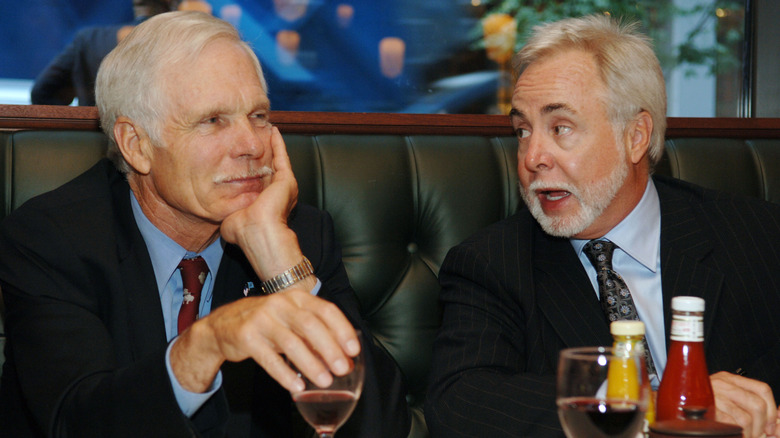14 Secrets About LongHorn Steakhouse You'll Wish You Knew Sooner
Since first opening its doors on August 10, 1981, LongHorn Steakhouse has become one of the most popular steakhouses in the U.S. As of this writing, there are over 550 LongHorn locations, and the eatery has at least one spot in 43 different states and territories. LongHorn did $1.81 billion in U.S. sales in 2021, ranking it 10th among full-service restaurant chains. Although this puts them in third place among steakhouses (behind Texas Roadhouse and Outback Steakhouse) it's still apparent people love a trip to LongHorn. We've been several times ourselves, and we always left with a full stomach and a smile on our face.
Beyond the steaks and sides, there are plenty of juicy tidbits about the company itself. For example, we recently learned that despite LongHorn's Wild West theme — the original name was LongHorn Steaks Restaurant & Saloon – the first location was in Atlanta, Georgia. Our curiosity piqued, and we decided to take a deep dive in search of other fascinating LongHorn nuggets and secrets worth sharing. While combing through an array of newspapers and magazines, data research, the LongHorn menu, and even court documents, we found 14 little-known LongHorn Steakhouse facts you'll wish you had known sooner.
1. The first location was a former adult bookstore
In keeping with its wild west vibe, it turns out LongHorn had a rebellious spirit right from the start as founder George McKerrow Jr. bought a vacated — and X-rated — bookstore to be his first location. The building was on Peachtree Road, a major Atlanta street that is currently home to multiple theaters, the Federal Reserve Bank, and a campus for the Savannah College of Art and Design among other destinations.
The colorful history of the first locale isn't the only odd thing about the lead-up to LongHorn's opening. Originally, McKerrow had $100,000 in backing from a financial partner. However, the partner bailed in March 1981, leaving McKerrow scrambling. His father, George McKerrow Sr., ended up providing part of the funding and became chairman of the parent company they created. Meanwhile, George Jr. directed building renovations by day while tending bar at night to help pay the bills.
It was a calamitous beginning to what would become one of America's most notable casual dining chains. Unfortunately, you can't go to the original LongHorn any longer unless you want to rent a vehicle as, by 2014, the first location was an Enterprise Rent-A-Car.
2. The founder was inspired by a movie
So how did a restaurateur in the middle of Atlanta settle on a Western theme? To paraphrase a classic saying, it was simply business. In 1981 the movie "Urban Cowboy" was popular, and when George McKerrow Jr. was planning the establishment, he just decided to choose it as the motif. That decision eventually led to a casual dining movement with some people crediting McKerrow for popularizing the "'Urban Cowboy' vibe" among eateries.
McKerrow also drew inspiration from another new kid on the restaurant block, recalling that a friend had taken him to the Hoffbrau Steak & Grill House which opened in 1978. Describing it as "Texas honky-tonk saloons," per Rough Draft Atlanta, McKerrow took a liking to the atmosphere and simple menu — especially since, while working for the Victoria Station dining chain, he had become disillusioned with steakhouses getting away from their roots. So, he zigged, adopting the Hoffbrau model of a basic menu and a fun place to go eat.
3. A snowstorm saved the first restaurant from going under
While those choices may seem logical in hindsight, LongHorn's early days were tough going — until Mother Nature lent a hand. George McKerrow Jr. was doing almost everything, reportedly telling Atlanta Business Chronicle in 1991 that he was a "cook, waiter, busboy, and bartend," (via Reference for Business). However, customers weren't exactly flocking to the new joint — even the official history notes the lack of guests, and LongHorn needed another dose of investment capital three months in to stay afloat.
So, what turned things around? An event known in Atlanta as "Snow Jam '82". That January, the city was hit by four inches of snow. That might not seem like much to people in places like Maine and North Dakota, but in a place that has gone four years without measurable snow on multiple occasions, it was enough to basically shut Atlanta down. For several days, the city ground to a halt, with thousands stuck at work or even leaving their cars on the interstate.
Those stranded travelers needed a place to eat and relax. With LongHorn being one of a handful of restaurants in its area that still had power, McKerrow pounced, doing a "Drinks $1 while it snows" special to lure people through the doors. They sold more than $700 worth of drinks on the first night of Snow Jam '82, and LongHorn Steakhouse credits the storm with making the restaurant what it is today.
4. It's primarily an East Coast restaurant
LongHorn was born in Georgia, but the Wild West atmosphere has made it a big deal in the Western U.S., right? Not exactly. By far, most LongHorn establishments are in the Deep South or along the East Coast. In terms of total locations, Florida has the most LongHorn steakhouses with over 70. Its home state of Georgia — which has roughly half the population of Florida — is second at around 68 locations, but Texas, Pennsylvania, North Carolina, and Ohio are not far behind. The city with the most LongHorn locales is also in Florida, as Orlando has a whopping eight.
On the other side, as of our publication date, there are still eight states without a LongHorn Steakhouse: Montana, Oregon, Washington, Nevada, Wyoming, Minnesota, Alaska, and Hawaii (plus Washington, D.C.). Not only that, but the states that historically made up the Wild West, including Arizona, New Mexico, Colorado, and Utah, all have fewer than 10 locations each. California might be the strangest of all, as the largest U.S. state by population only has three LongHorn Steakhouse eateries. The first one didn't even open until 2020.
5. It's part of a bigger steakhouse empire
It probably doesn't shock you to know that LongHorn Steakhouse is part of a food conglomerate. In 2007, Darden Restaurants acquired RARE Hospitality International, Inc., the parent corporation of LongHorn, for a total of $1.4 billion in combined cash and debt obligations. That made LongHorn part of a group that includes many other notable restaurant brands, including Olive Garden, Bahama Breeze Island Grille, Cheddar's Scratch Kitchen, and Seasons 52.
But, did you know LongHorn is officially a cousin of two other national steakhouse chains? At the time of the acquisition, RARE International already owned The Capital Grille, which is the fifth-largest U.S. steakhouse by sales as of 2021 (via Statista). Then in June 2023, Darden Restaurant finalized the purchase of Ruth's Chris Steak House, which is the fourth-largest steakhouse chain. The combined sales of the three nameplates have them nipping at the heels of Texas Roadhouse, making the steakhouse playing field as interesting as it is crowded.
6. They were sued by workers over pay
Unfortunately, a darker side to the LongHorn ethos has reared its head. In early 2023, a class action lawsuit was filed in South Carolina against RARE Hospitality alleging that LongHorn workers weren't being paid correctly (via Top Class Actions). The lawsuit claimed tipped-wage employees were made to do "non-tipped side work" for more than 20% of their hours, which is a violation of federal labor laws. It also asserted workers weren't given sufficient notice of LongHorn's tip credit policy in which tips are included when determining the employee's final pay amount.
The lawsuit was withdrawn in May 2023, a few days after both parties said they were in settlement talks (via ClassAction.org). The terms of any such settlement are not known. However, it's not the first time LongHorn or its parent companies have been in trouble. In the previous year, a lawsuit making almost identical allegations against LongHorn was filed by a Pennsylvania plaintiff against GMRI, Inc., another subsidiary of Darden Restaurants. In 2021, Darden itself was targeted in a lawsuit by One Fair Wage alleging its tipping wage policies led to workers being sexually harassed and discriminated against (via CaseText). The lawsuit was dismissed by the 9th U.S. Circuit Court of Appeals in August 2023, but this checkered recent history is something worth considering
7. The COVID-19 pandemic led to some menu changes
Like pretty much every restaurant, LongHorn Steakhouse was put in a unique predicament when the COVID-19 pandemic hit. Multiple changes made as a result are still felt today. Not only has LongHorn been working to improve overall food quality, but in 2022, an earnings call revealed they were now serving larger portions of most steaks. According to Darden Restaurants CEO Ricardo Cardenas, this is because they wanted visitors to offer at least the perception of a bargain, especially in the face of high inflation.
Also, a former LongHorn steakhouse employee says the pandemic led to LongHorn discontinuing its roasted prime rib offering. As the employee explains it, prime rib never showed much profit anyway. When the pandemic led to supply chain issues and skyrocketing beef prices, the company quietly dropped the dish from its menu.
The changes are paying off for LongHorn. In the period of March to May 2022, same-store sales were up 10.6% from the previous year, and in March to May 2023, they enjoyed a year-over-year revenue rise of another 7.1%, far surpassing expectations. There is one notable non-change, though. Even with other restaurants jumping on the delivery bandwagon, LongHorn refuses to do so. This is because they don't want to deal with the large fluctuations in demand that can hurt profit margins.
8. You can become a LongHorn Grill Master Legend
The next time you get a LongHorn steak, it just might be grilled by a legend. LongHorn does special training for its steak cooks, and those who complete it officially become a Grill Master. If a cook stays at LongHorn long enough to grill one million steaks for them, they are bestowed with the title of Grill Master Legend.
Receiving this title is rare indeed. In 2023, Tony Behrens of Symmes Township, Ohio became one of only 25 Grill Master Legends honorees (via WCPO ABC 9). He received $5,000 and a gold chef's coat with company president Todd Burrowes on hand for the presentation. It took Behrens 26 years to reach the mark, meaning he grilled more than 100 steaks a day on average during that time. That's a lot of steak grilling.
It's not the only way LongHorn celebrates its chefs. Every year, thousands of Grill Masters take part in the months-long Steak Master Series to show off their grilling skills. The 2023 finals were held in Orlando with Kylie Hall of Lenoir City, Tennessee being named Steak Master Series Champion (via WATE ABC 6). She became the second woman to win the competition, pocketing $15,000 along with the title.
9. Longhorn Steakhouse once had a grilling advice hotline
LongHorn Steakhouse is known for freely giving out steak cooking tips — a quick Google search will uncover loads of advice from their team. But, you may not know that, for a time, you could call a phone number for advice. In a July 2013 press release, LongHorn Steakhouse announced the Grill Us Hotline in time for Independence Day cookouts (via Cision PR Newswire). Company Grill Masters manned the hotline, answering questions by phone, text, or their Facebook page. You could ask them about different cuts of steak, proper grilling temperatures, and other tips to produce a delicious and safe meal.
The Grill Us Hotline ran for more than half a decade between late May and early September, covering the summer grilling season from Memorial Day through Labor Day. You could even ask about marinade vs. seasoning and how a steak should look when it comes off the grill. Unfortunately, it appears the hotline has been discontinued, as the last reference seems to be from May 2019. Still, we're holding out hope that the Grill Us Hotline will return to help guide summer cookouts.
10. LongHorn steaks are fresh, but it doesn't make much difference
One of LongHorn's selling points has long been its quality. They claim the steaks served are fresh and never see a freezer. Why is this? According to the company's master chefs, frozen steaks are harder to cook the right way than fresh steaks are, and freezing them can affect the meat's quality, even when you're working with premium cuts of meat.
However, fresh steak may not provide all the advantages they're promoting. In a Kansas State Research and Extension study, results showed consumers found no discernable quality difference between fresh beef versus beef that had been frozen and thawed. While never-frozen beef was usually juicier, the frozen-and-thawed version was more tender when cooked. This likely is at least in part because fresh beef experiences natural aging whereas frozen beef does not.
Furthermore, cooking a steak from a frozen state may even produce a better final product. An experiment by America's Test Kitchen found that, compared to a thawed steak, frozen beef cooked more evenly, retained more moisture, and had a thinner gray band around the exterior. We're guessing none of this information will change LongHorn's practices, though. As wryly noted by Sustainable Agriculture Research and Education (SARE), "We have yet to meet a chef who will accept a frozen product."
11. You can save money by going for lunch
Steakhouses are known for being and expensive place to eat — the priciest steakhouses can easily exceed $100 for a three-course meal. But, if you're looking to treat yourself to a steak while saving a little scratch, lunchtime at LongHorn is a good way to do it.
The LongHorn Steakhouse lunch menu features all seven of the steaks from the full dinner menu, including the signature Outlaw Ribeye®, the Renegade Sirloin, the New York Strip, and the LongHorn Porterhouse. They're the same portion size with a slightly lower price, although it may not include as many extras. For example, the Outlaw Ribeye is $31.79 for lunch at the Rancho Cucamonga (CA) location and $33.29 for dinner, but the lunch version only comes with one side instead of two.
Still, every dollar counts, and if you didn't think you'd have room for the second side anyway — which wouldn't be a surprise after devouring a 20-ounce ribeye — lunch is an attractive option. The lunch menu is available Monday to Saturday from 11:00 a.m. to 3:00 p.m. If you don't feel like a steak, there are plenty of other reduced-price lunch items, including burgers, seafood, chicken, and entrée salads.
12. It's easy to eat low-carb meals at LongHorn Steakhouse
Low-carbohydrate diets are a common eating approach for weight control and lowering disease risk, according to the Mayo Clinic. The International Food Information Council found that, in 2022, 7% of Americans followed a low-carb or ketogenic (i.e. keto) diet at some point. Of course, when you go out to eat, you don't have to look far to see an avalanche of carb-heavy foods like bread, rice, and potatoes — and LongHorn Steakhouse is no exception. A 126-carb Texas Tonion, anyone?
But, one thing LongHorn does well is making it easy to follow a low-carb diet plan when dining out. For starters, they publish all their nutritional information online so you can see what's low-carb and what isn't. A look through the Longhorn Steakhouse Nutrition & Allergen Guide shows more than 30 menu items that have fewer than 20 grams of net carbs in their regular form. You can also special-order items without sauces and other add-ons that add unwanted carbs.
The pièce de résistance is that they have a separate keto menu. The LongHorn Steakhouse Keto Friendly Menu includes plenty of mouth-watering entrees like the Fire-Grilled T-Bone and Flo's Filet. For sides, you get a crouton-free salad and broccoli, which can be replaced with asparagus for an upcharge. Just request the keto menu when you arrive if you want to eat low-carb.
13. There are two different grilling options
A grill is a grill, right? Not at LongHorn Steakhouse. Each restaurant has a char grill and a flat-top grill in its kitchen. If you're wondering what the difference is, a char grill (also called a charbroiler) is an open-flame grill that has a heating element beneath the grates and is usually gas-powered. A flat-top grill is comparable to a sauté pan or griddle with a solid heated surface that is slightly curved to move fats and juices away from what you're cooking.
So, which one gets used when? According to restaurant manager Janet Dickey, the only steaks regularly cooked on the char grill are bone-in steaks and New York strip steaks. This is because the bones and fat marbling change a steak's flavor profile, which is further enhanced by the open-flame design. All other steaks and meats are by default cooked on the flat-top grill.
That doesn't mean you're stuck with the official method, though. Any customer can ask for their steak to be cooked on either grill. So, if you want your sirloin steak to have grill marks and a smoky taste, ask for the char grill next time. Or, get your strip steak cooked on the flat-top for a juicier texture and thinner crust.
14. The founder started another grilling-themed restaurant
So, what is George McKerrow Jr., the man who started LongHorn, up to these days? He's still involved in grilling — just in a different way. Not long after McKerrow retired from LongHorn Steakhouse following nearly 20 years with the company, he joined forces with media mogul and fellow Atlanta resident Ted Turner on another restaurant venture. Ted's Montana Grill would be more akin to a gourmet hamburger joint — one that would be serving up bison, of which there were plenty residing on Turner's ranch lands.
Like LongHorn, the first Ted's Montana Grill opened on Peachtree Road in Atlanta. Currently, there are nearly 40 Ted's Montana Grill restaurants spread across 16 states. (And yes, there is one in Montana –Bozeman, to be exact.) In an interesting twist, by serving bison, McKerrow and Turner may have played a role in saving them. In a press release celebrating the restaurant's 20th anniversary, Ted's Montana Grill claimed their efforts had helped double the total U.S. bison population to half a million.
Ted's Montana Grill was also a leader in sustainable restaurant practices — among other things, they claim to be the first eatery to abandon plastic drink straws. And, after 50-plus years in the industry, McKerrow is still working hard, serving as a speaker at the 2023 NextGen Restaurant Summit to teach the next wave of pioneering restauranteurs.
